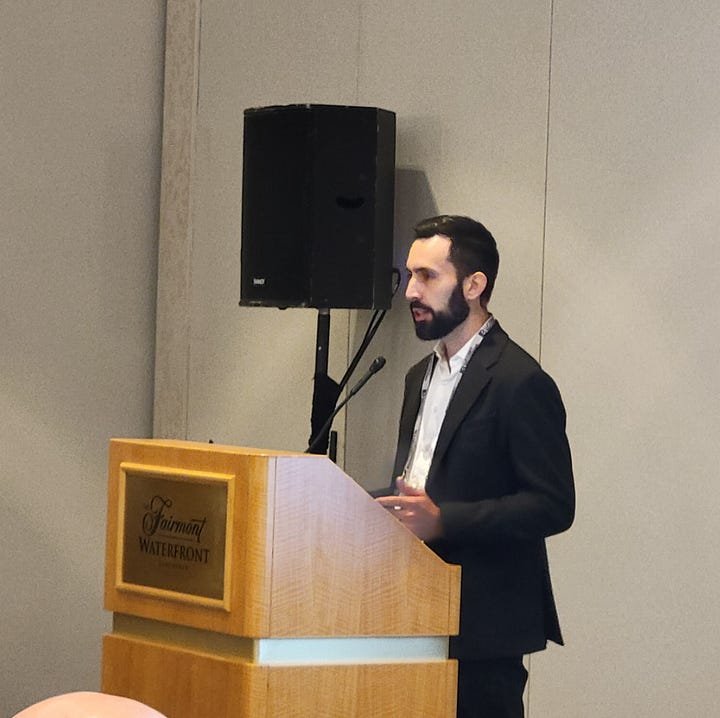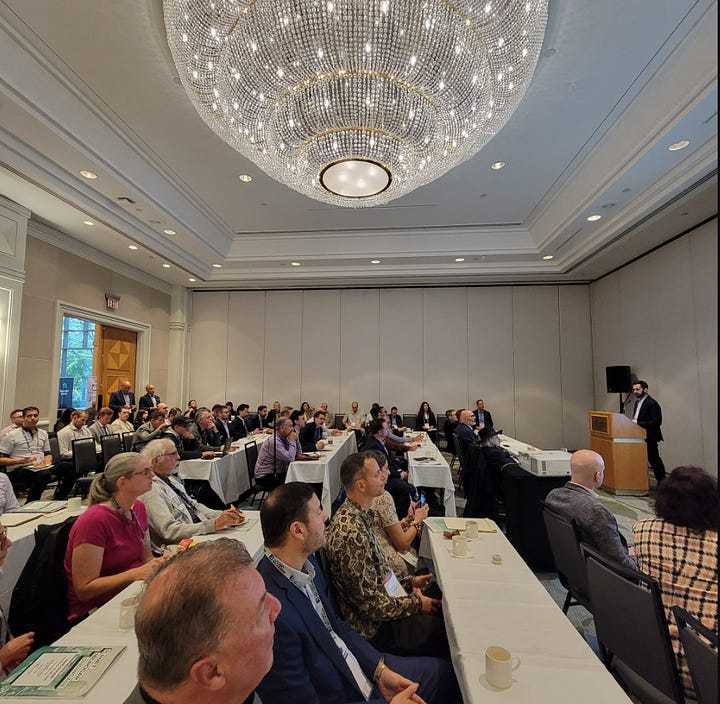To learn more about microcap strategies or the Rivemont MicroCap Fund, check out this post and see the disclaimer at the bottom.
A month ago, I travelled to Vancouver to attend a conference. Two of my favourite organizations in the microcap space, Planet MicroCap and Smallcap Discoveries, joined forces to create what I think was one of the best conferences I ever attended.
The two-day event had everything you’d want: a super high-quality company lineup, educational keynotes, and great people to meet during the breaks and cocktails. It was fantastic to reconnect with old friends and meet new ones.
When I attend conferences, I tend to have many one-on-one meetings with companies. Most microcaps aren’t covered by analysts, and little information is available publicly. You can really gain a deeper understanding of a business when you spend time asking the CEO questions.
For this conference, I had 17 meetings. Typically, I expect at least half of the meetings to be mediocre or even totally useless. The problem is that you can’t tell which ones in advance. I’ve been surprised countless times by a company I wasn’t super excited to meet, only to come away rushing to do more research (there’s one example below). That’s why I try to turn over as many rocks as possible - you never know what you’ll find. And honestly, the batting average at this conference was much higher. Most meetings were actually excellent.
I won’t provide a recap of all the companies I met, but I’ll give you some of my main highlights: the standouts, the companies I’m keeping at the top of my watch list, and the one that surprised me the most.
Let’s dive in!
The Standouts
#1 - Covalon Technologies (TSX-V: COV)
I was looking forward to meeting with Covalon mainly because it would allow me to meet Brent Ashton, the new CEO, who was appointed earlier this year. Brent came in when the company had posted nine consecutive quarters of net losses alongside lumpy and unpredictable revenue patterns.
Brent quickly changed the org chart to improve collaboration between the different departments and employee morale.
Impressively, the company immediately swung from losses to strong profitability due to significant revenue growth and a tight focus on controlling expenses (he won’t take credit for everything, which is fair).
Brent looks pretty excited about the future and mentioned that growing the current product lines has a ton of upside. The company’s two main categories are wound care (collagen platform) and vascular access (silicon adhesive platform).
In wound care, Covalon’s two main competitors (Solventum and Medline) are very distracted, enabling the company to gain market share. Covalon estimates it has a mid-teens (~15%) market share.
The vascular access market share is less than 1%, and Brent thinks most of the growth will come from there. Over the long term (5 to 7 years), the vascular access category should overtake wound care as the primary revenue contributor. It is a large market where Covalon can establish itself as a strong second supplier next to 3M’s standard of care.
Overall, I came away very excited about the long-term growth prospects for Covalon and especially about the leader in charge.
#2 - Biorem (TSX-V: BRM)
The thesis on Biorem is fairly simple. They provide air emission control systems to eliminate odours and air pollutants. They are also very active in the municipal space, with wastewater and solid waste management facilities.
Over the last few years, Biorem has won many new contracts and built up a record backlog of $57 million (as of June 30, 2024). This backlog typically gets delivered over the next 12 to 18 months with near 100% certainty (once a project is contracted and added to the backlog, it’s almost impossible to lose it).
Based on historical revenue figures ($24 to $28 million in revenue per year during the last four years), it’s pretty easy to see the kind of growth that Biorem will be able to generate over the next couple of years based on its current backlog. From a quarterly perspective, it will be lumpy based on the delivery schedule, so taking a longer-term view (yearly) makes more sense.
Strong second-half results (especially Q3) and potential M&A activity are catalysts to watch. Derek mentioned he has a few deals in the pipeline, and one seemed fairly advanced. The lumpiness should also play in Biorem’s favour as Q3 is shaping up to be a solid quarter based on project deliveries in the quarter.
#3 - McCoy Global (TSX: MCB)
In April, McCoy was also one of my standouts at the Planet MicroCap Showcase VEGAS. Alas, I didn’t buy the stock, which has been doing well lately. My main concern was the cyclicality of being an equipment and service provider to the oil & gas industry.
The story I heard in Vancouver was the same as in Las Vegas: it’s a softer market, especially in the US, but McCoy keeps growing by gaining market share. Why? Because their new technology offerings are safer and require less labour than competitive products, which provides a strong ROI for their clients.
McCoy is also looking to launch an integrated package with its smart technologies, powered by software and monetized under a SaaS model. The SaaS component will obviously increase gross margins and add predictability to the revenue base.
I remain very impressed with the execution here.
Watch List Candidates
#4 - Thermal Energy International (TSX-V: TMG)
I’ve been following TMG for a while. I like the CEO, William Crossland. He’s thoughtful, patient, and long-term focused.
The stock had a bit of a tough time during the last few months as the company started investing in future growth by increasing operating expenses (bigger sales team, new facility in the UK, new mobile app). Those investments led to a short-term decline in profitability, which the market didn’t like.
Fundamentally, the business and the industry seem to be in good shape. The company's investments are short-term pain for long-term gain (at least, that’s the plan). They should lead to increased revenue growth over the coming years and, ultimately, higher profitability.
Unfortunately, most investors don’t have a 2- to 3-year investment horizon, which creates opportunities for someone willing to look past these temporarily depressed earnings.
#5 - Crescita Therapeutics (TSX: CTX)
Those who’ve been following Crescita for a significant amount of time know that the stock has been a value trap. Although the business has changed over the years (in positive and negative ways), the stock price is the same as seven years ago.
The company has $9 million in cash on the balance sheet, no debt, and trades at an $11-12 million market cap. The market is assigning almost no value to the operating business.
Crescita has three main revenue streams: the sale of non-prescription skincare products, the contract manufacturing of skincare products for other brands, and royalties on a prescription product called Pliaglis that’s out-licensed to partners worldwide.
I recently became more interested in Crescita due to an acquisition and several new contract announcements (look up the press releases since June). These announcements should lead to revenue growth on the non-prescription side of the business. On the prescription side, the company is in talks to find a new partner for Pliaglis in the US, which could lead to a few million $ of additional royalties per year over time.
It’s still too early to tell if the company will be able to grow revenues and sustain profitability on an ongoing basis, but if they do, it likely won’t trade at this valuation for long. Deep-value investors should keep an eye on this one.
My Biggest Surprise
#6 - Baylin Technologies (TSX: BYL)
I took this meeting out of curiosity. I knew little about the business and had very modest expectations, but I always like to meet new companies and develop a first impression of the CEO.
In this case, I was very impressed!
Baylin doesn’t have a stellar track record as a business. The stock has been down over 80% during the last ten years. Leighton Carroll, the current CEO, took the helm in June 2021 when the company had $37 million in debt, negative working capital, declining revenues, no gross margins and significant operating losses. It was a mess.
In three years, he executed what looks like a solid turnaround. In its most recent quarter, Baylin showed modest revenue growth (3%), decent gross margins (42%), positive and growing adjusted EBITDA ($1.7 million), and a reduced debt load ($16.6 million).
Leighton walked me through his background and track record. You quickly realize this is not his first rodeo, and the results speak for themselves.
I need to do a lot more work to understand the business better, but so far, it looks interesting!
Keynote Speech
On the second day of the conference, I gave a keynote speech titled ‘‘Canadian MicroCap M&A - What Happened Recently’’. I provided an overview of the current microcap market with some stats, followed by a recap of the M&A transactions over the last 18 months and a few reasons to be bullish for the future.
The replay should be available on YouTube shortly, so stay tuned for that!


(Thanks to Koukun Unosawa for the pictures!)
I don’t have any other travel plans for the remainder of this year. My focus will be on hosting local events in Montreal with Rivemont. We have one coming up on November 19th at 5 pm. If you happen to be in Montreal that day, please come say hi in person! You can find all the details HERE.
I hope this recap was helpful. Feel free to let me know your thoughts about these companies (or the ones I missed) in the comments!
Disclaimer
This publication is for informational purposes only. Nothing produced under the Stocks & Stones brand should be construed as investment advice or recommendations. Mathieu Martin, the author, is employed as a Portfolio Manager with Rivemont Investments. This publication only represents Mathieu Martin’s own opinions and not those of Rivemont. Rivemont may own positions and transact on any securities mentioned in this publication at any time without prior notice. At the time of this writing, the Rivemont MicroCap Fund holds shares of Covalon Technologies (TSX-V: COV) and Biorem (TSX-V: BRM). Always do your own research and consult a professional before making investment decisions.
If you’d like to invest in small public companies, check out this post.





Your speech was great.